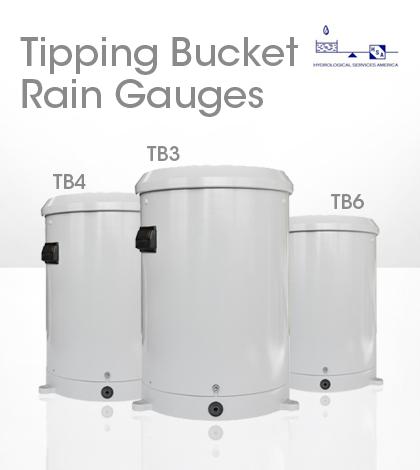Hydrological Services tipping bucket rain gauges: Better accuracy, built to last

Tipping bucket rain gauges are often seen as simple devices and similar across the board. But picking the right gauge has serious implications on data quality and research success.
There are many important factors that should be considered when selecting a tipping bucket rain gauge. These include:
- Region: What is the expected range of intensities the rain gauge will measure?
- Accuracy: What level of accuracy is acceptable?
- Return Frequency: Up to what return frequency do you wish to measure accurately?
- Reliability: What is the expected level of reliability over time?
Hydrological Services has kept that in mind, making significant improvements to tipping bucket technology over the years. The company’s TB3, TB4 and TB6 rain gauges are the result. With innovative features and superior construction, they are renowned for their accuracy, quality and long-term stable calibration.
Without some form of correction, tipping bucket rain gauges will under-report as rainfall intensity increases. This is generally minimal at low intensities, but this underreporting is unacceptably high during storms.
“Basically, what many manufacturers either don’t know or don’t know how to address is that, as rainfall intensity increases, so does the amount of water lost during each tip of a bucket. This loss is the fundamental reason for inaccuracy in many rain gauges,” said Peter Ward, founder and CEO of Hydrological Services America.
Ward says that tipping bucket operation travels through an arc, so a bucket that begins tipping at a set volume of water will contain more water at the end of its arc because rainfall has continued to come in. “The higher the rainfall intensity, the greater the loss, the worse the error,” said Ward.
Tests of uncorrected gauges have revealed error rates as high as 15 percent. “People are shell-shocked when they see the comparison data,” said Ward.
To account for rainfall extremes, the TB3 and TB4 models come with ‘Siphon Control’ that achieves 2 percent accuracy up to 250 millimeters per hour and 3 percent all the way up to 500 millimeters of rain per hour. The TB6 model is ideal for naturally drier areas where rainfall will likely be less intense. Its accuracy ranges from better than 1 percent from 0 to 50 millimeters per hour, better than 2 percent from 50 to 75 millimeters per hour and better than 4 percent for intensities from 75 to 100 millimeters per hour.
The TB4 and TB6 models have a similar construction, featuring a cast aluminum funnel and enclosure with a base of UV-resistant ABS plastic. The TB3 is all-aluminum, featuring the same cast aluminum funnel and enclosure but with a solid die-cast aluminum base as well. The TB3 also features Sapphire bearings in the tipping mechanism, whereas the TB4 and TB6 feature stainless steel rolling bearings.
“It took us five or six years to develop and perfect the simple mechanical design of our rain gauges. With sapphire bearings, the fail rate is 200-odd years under normal environmental conditions,” said Ward. “Cheaply built gauges typically won’t last very long in harsh environments due to the sub-standard materials used in their manufacture.”
Additionally, all of the exposed metal components on HS’s tipping bucket rain gauges are coated in tough, durable heat-cured paint, making them highly resistant to salt-related corrosion and ideal for coastal areas.
Instead of the flat, grill-type leaf filter found on most gauges, Hydrological Services use a steep-sloped funnel design with a tall “finger filter” mounted in the bottom center that does a better job of keeping debris from getting into the tipping mechanism.
Hydrological Services uses quick-release screws to secure the tipping bucket enclosure. Being able to loosen the screws slightly to slide off the enclosure makes it easier to check the switches and tipping bucket or download data if an internal data logger is being used, like HS’s ML1-FL.
But in terms of maintaining a gauge, most users only need to visit the monitoring site periodically. Ward says that periodic cleaning of rain gauges is the best way to ensure uninterrupted, good quality data. Cleaning is very simple and takes only 5-10 minutes. A basic maintenance kit of pipe cleaners, some wood alcohol or liquid soap, a small brush and some water is all that’s required.
Calibration is performed using an HS field calibration tube that maintains constant gravity and lets users control the exact amount of water that goes through the rain gauge.
Hydrological Services tipping bucket rain gauges come with a three-year warranty and are built to last. “The TB3 should last 50-plus years,” said Ward. “We try to build a good product at a fair price. Buy it once, buy it right.”





0 comments